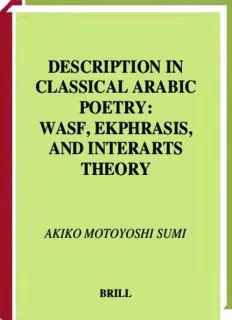
Description in Classical Arabic Poetry: Wasf, Ekphrasis, and Interarts Theory (Brill Studies in Middle Eastern Literatures) (Brill Studies in Middle Eastern Literatures) PDF
Preview Description in Classical Arabic Poetry: Wasf, Ekphrasis, and Interarts Theory (Brill Studies in Middle Eastern Literatures) (Brill Studies in Middle Eastern Literatures)
DESCRIPTION IN CLASSICAL ARABIC POETRY: WASF, EKPHRASIS, AND INTERARTS THEORY AKIKO MOTOYOSHI SUMI BRILL BSMEL-25-motoyoshi sumi.qxd 09/09/2003 16:57 Page i DESCRIPTION IN CLASSICAL ARABIC POETRY BSMEL-25-motoyoshi sumi.qxd 09/09/2003 16:57 Page ii BRILL STUDIES IN MIDDLE EASTERN LITERATURES SUPPLEMENTS TO THE JOURNAL OF ARABIC LITERATURE The series Studies in Arabic Literature has now expanded its purview to include other literatures (Persian, Turkish, etc.) of the Islamic Middle East. While preserving the same format as SAL, the title of the expanded series will be Brill Studies in Middle Eastern Literatures (BSMEL). As in the past, the series aims to publish literary critical and historical studies on a broad range of literary materials:classical and modern, written and oral, poetry and prose. It will also publish scholarly translations of major literary works. Studies that seek to integrate Middle Eastern literatures into the broader discourses of the humanities and the social sciences will take their place alongside works of a more technical and specialized nature. EDITED BY Suzanne Pinckney Stetkevych VOLUME XXV BSMEL-25-motoyoshi sumi.qxd 09/09/2003 16:57 Page iii DESCRIPTION IN CLASSICAL ARABIC POETRY WA‘F, EKPHRASIS, AND INTERARTS THEORY BY AKIKO MOTOYOSHI SUMI BRILL LEIDEN •BOSTON 2004 BSMEL-25-motoyoshi sumi.qxd 09/09/2003 16:57 Page iv This book is printed on acid-free paper. Library of Congress Cataloging-in-Publication Data Sumi, Akiko Motoyoshi. Description in classical Arabic poetry : waßf, ekphrasis, and interarts theory / by Akiko Motoyoshi Sumi. p. cm. Includes bibliographical references (p. ) and index. ISBN 90-04-12922-7 (alk. paper) 1. Arabic poetry—History and criticism. 2. Ekphrasis. I. Title. PJ7541.S84 2003 892.7’1009—dc22 2003057806 ISSN 0169-9903 ISBN 90 04 12922 7 © Copyright 2004 by Koninklijke Brill NV, Leiden, The Netherlands All rights reserved. No part of this publication may be reproduced, translated, stored in a retrieval system, or transmitted in any form or by any means, electronic, mechanical, photocopying, recording or otherwise, without prior written permission from the publisher. Authorization to photocopy items for internal or personal use is granted by Brill provided that the appropriate fees are paid directly to The Copyright Clearance Center, 222 Rosewood Drive, Suite 910 Danvers, MA 01923, USA. Fees are subject to change. PRINTEDINTHENETHERLANDS Motoyoshi/f1/v-xvii 9/10/03 10:02 AM Page v v To the memory of my mother Tomoko Motoyoshi This page intentionally left blank Motoyoshi/f1/v-xvii 9/10/03 10:02 AM Page vii vii CONTENTS Preface ........................................................................................ ix Acknowledgments ........................................................................ xv A Note on Translation and Transliteration ............................ xvii Introduction ................................................................................ 1 Chapter One Contest as Ceremony: A Pre-Islamic Poetic Contest in Horse Description of Imru" al-Qays vs. 'Alqamah al-Fa˙l ...................................................................................... 19 Chapter Two Remedy and Resolution: Bees and Honey-Gathering in Two Hudhalì Odes ................................................................ 61 Chapter Three Reality and Reverie: Wine and Ekphrasis in the 'Abbàsid Poetry of Abù Nuwàs and al-Bu˙turì .................................. 92 Chapter Four Sensibility and Synaesthesia: Ibn al-Rùmì’s Singing Slave-Girl ................................................................................ 122 Chapter Five Poetry and Portraiture: A Double Portrait in a Panegyric by Ibn Zamrak ...................................................................... 155 Conclusion .................................................................................. 194 Appendix of Arabic Texts ........................................................ 199 Works Cited ................................................................................ 235 Index ............................................................................................ 243 This page intentionally left blank Motoyoshi/f1/v-xvii 9/10/03 10:02 AM Page ix ix PREFACE At present, we scarcely find secondary literature on the subject of classical Arabic poetry or the qaßìdah studied from the perspective of modern Western literary theories and interartistic perspectives. This book demonstrates that those contemporary theories are useful for discovering and reconstructing a possible original meaning of the qaßìdah. This study was submitted in its original version as a doctoral dis- sertation to the Department of Near Eastern Languages and Cultures, Indiana University (October 2001); the study has now been reassessed and revised. The subject of the study is waßf or “description” as one of the salient characteristics of the qaßìdah tradition. We find some- thing similar to waßf in the Western tradition under the name of ekphrasis. Originally interpreted in the Western rhetorical tradition as “clear and distinct description” of any object, ekphrasis in its mod- ern understanding bears a more limited sense, “verbal representa- tion of non-verbal texts.” In this modern conception, ekphrasis is concerned with the transdisciplinary field of intermedial and inter- arts studies. This study aims at reexamining the functions and significance of waßf in a selected group of Arabic qaßìdahs. My goal is to reveal unrecognized aesthetic dimensions in the qaßìdah genre in a way that is consistent with Western critical discourse. I employ various theo- ries of culture and anthropology, of art history, and of interarts stud- ies, including the concept of ekphrasis, which refers to the representation in verbal art of the other arts: painting, singing performance, and architecture. The qaßìdah must be analyzed within its conventional framework in light of its thematic unity and “frame of reference” (a set of stan- dards, beliefs, or assumptions governing perceptual or logical evalu- ation or social behavior).1 One aspect of classical Arabic poetry’s conventionality, reflected in every ode in this study, is its bipartite 1 The Oxford English Dictionary, 2nd ed., s.v. “frame of reference.” For its further meaning, see pp. 124–25 in Chap. 4.
Description: